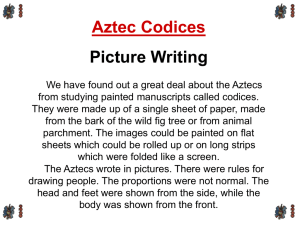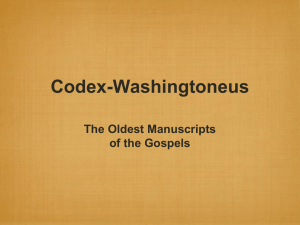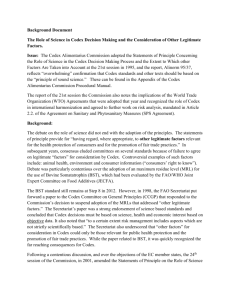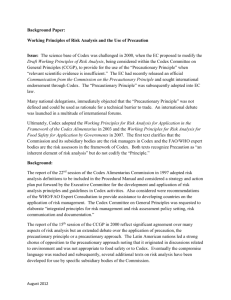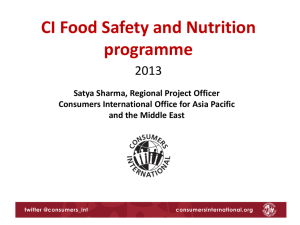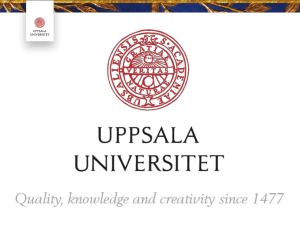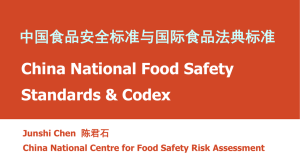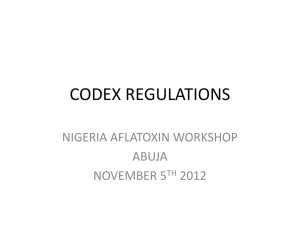MEMORY OF THE WORLD REGISTER Codex Argenteus – the
advertisement
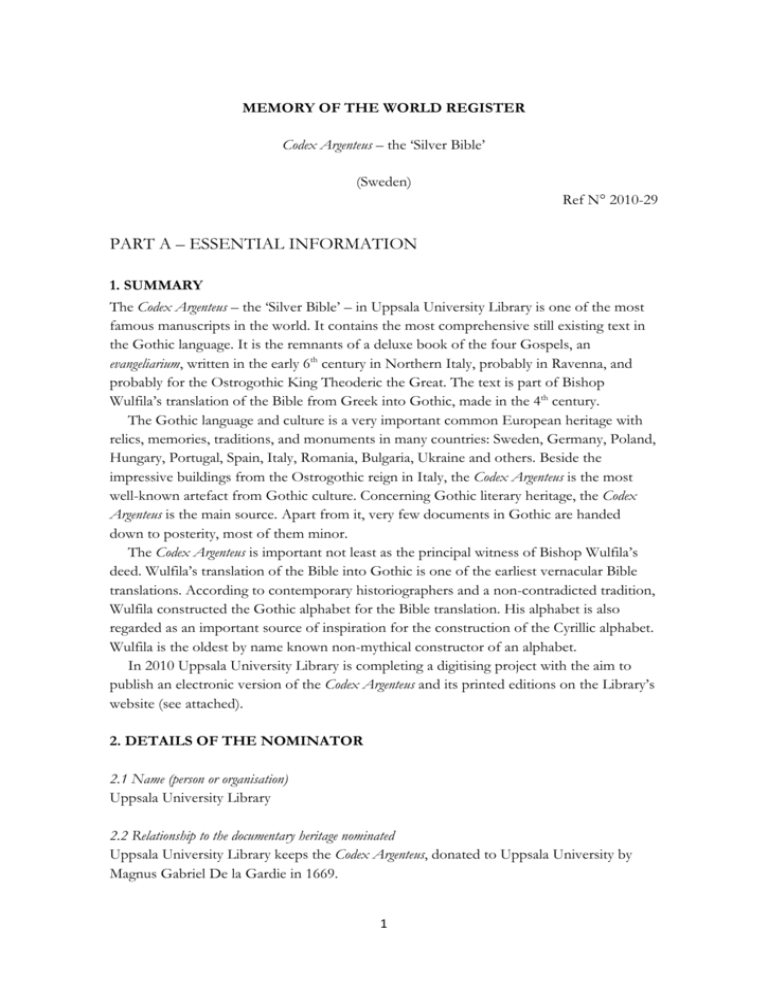
MEMORY OF THE WORLD REGISTER Codex Argenteus – the ‘Silver Bible’ (Sweden) Ref N° 2010-29 PART A – ESSENTIAL INFORMATION 1. SUMMARY The Codex Argenteus – the ‘Silver Bible’ – in Uppsala University Library is one of the most famous manuscripts in the world. It contains the most comprehensive still existing text in the Gothic language. It is the remnants of a deluxe book of the four Gospels, an evangeliarium, written in the early 6th century in Northern Italy, probably in Ravenna, and probably for the Ostrogothic King Theoderic the Great. The text is part of Bishop Wulfila’s translation of the Bible from Greek into Gothic, made in the 4th century. The Gothic language and culture is a very important common European heritage with relics, memories, traditions, and monuments in many countries: Sweden, Germany, Poland, Hungary, Portugal, Spain, Italy, Romania, Bulgaria, Ukraine and others. Beside the impressive buildings from the Ostrogothic reign in Italy, the Codex Argenteus is the most well-known artefact from Gothic culture. Concerning Gothic literary heritage, the Codex Argenteus is the main source. Apart from it, very few documents in Gothic are handed down to posterity, most of them minor. The Codex Argenteus is important not least as the principal witness of Bishop Wulfila’s deed. Wulfila’s translation of the Bible into Gothic is one of the earliest vernacular Bible translations. According to contemporary historiographers and a non-contradicted tradition, Wulfila constructed the Gothic alphabet for the Bible translation. His alphabet is also regarded as an important source of inspiration for the construction of the Cyrillic alphabet. Wulfila is the oldest by name known non-mythical constructor of an alphabet. In 2010 Uppsala University Library is completing a digitising project with the aim to publish an electronic version of the Codex Argenteus and its printed editions on the Library’s website (see attached). 2. DETAILS OF THE NOMINATOR 2.1 Name (person or organisation) Uppsala University Library 2.2 Relationship to the documentary heritage nominated Uppsala University Library keeps the Codex Argenteus, donated to Uppsala University by Magnus Gabriel De la Gardie in 1669. 1 2 2.3 Contact person (s) Ulf Göranson, Library Director. Ulf.Goranson@ub.uu.se Anders Edling, Head, Manuscripts and Music. Anders.Edling@ub.uu.se Lars Munkhammar, Codex Argenteus Specialist. Lars.Munkhammar@ub.uu.se 2.4 Contact details (include address, phone, fax, email) Uppsala University Library Box 510 SE–751 20 Uppsala Sweden Phone: +46 18 4713900 E-mail: Ulf.Goranson@ub.uu.se 3. IDENTITY AND DESCRIPTION OF THE DOCUMENTARY HERITAGE 3.1 Name and identification details of the items being nominated The Codex Argenteus is listed as DG 1 in the inventory of manuscript collections at Uppsala University Library. Donated to Uppsala University in 1669, it is owned by the Swedish State and (according to the donor’s provision) to the University Library »... consecrated as an everlasting possession.« Uppsala University Library, Box 510, SE–751 20 Uppsala, Sweden. 3.2 Description The shelf mark is DG 1 (The De la Gardie Collection No. 1). Silver- and gold-ink on very thin (0.11–0.12 mm on average plus/minus some tenths of a millimetre) purple parchment. The codex originally consisted of at least 336 leaves. Of these, 187 are extant in Uppsala. One other leaf (as far as we know) has survived – in Speyer in Germany. It was sensationally discovered in 1970 in the Speyer Cathedral along with some hidden relics of a saint. Today it is kept in Historisches Museum der Pfalz Speyer, Germany. The width of the leaves of Codex Argenteus is between 19.75 and 20 cm. The height is between 24.25 and 24.50 cm. The leaf in Speyer, found in 1970, is 21.7 cm at its widest and 26.5 cm at its highest. Probably this is quite close to the original size. When De la Gardie donated the codex to Uppsala University, he had provided it with a binding in chased silver, made in Stockholm by the Court goldsmith, Hans Selling, according to a design by David K. Ehrenstrahl. Today it is reasonable to regard this silver cover as part of the codex. De la Gardie purchased the Codex Argenteus from Isaac Vossius in 1662. Vossius had been one of Queen Christina’s librarians, and when the Queen abdicated and moved to Rome in 1654, Vossius received the Codex Argenteus and some other codices from her as compensation for non-payment and for books she had borrowed from him. The Codex Argenteus had come to Christina’s library as a piece of the enormous Swedish war booty from Prague in 1648. The codex had been taken to Prague by Rudolf II. In the middle of 3 the 16th century it had been discovered in the Werden Monastery (today Essen-Werden), and the way from Werden to Prague is hidden in darkness as is the way from Ravenna to Werden. The main part of the manuscript is preserved on premises with climate control, each leaf enveloped in acid-free paper. Two double leaves are usually on display in a security show-case. The climate conditions for these leaves are regularly controlled. The silver script has become darker through the centuries by natural reasons. However, a scientific investigation of the writing materials has never been made. Visual documentation will be attached to this nomination proposal. The Codex Argenteus is the subject of a comprehensive literature. The scientifically most genuine and substantial work is Otto von Friesen’s and Anders Grape’s monograph about the codex. Unfortunately it is quite antiquated, and its two versions are written in very exclusive languages: Latin and Swedish. The titles: FRIESEN, Otto von & GRAPE, Anders, »Introductio.« Codex Argenteus Upsaliensis Jussu Senatus Universitatis Phototypice Editus. Uppsala – Malmö [1927], pp. 11–118. FRIESEN, Otto von & GRAPE, Anders, Om Codex argenteus. Dess tid, hem och öden. (Skrifter utgivna av Svenska litteratursällskapet, 27.) Uppsala 1928. Lars Munkhammar’s monograph Silverbibeln – Theoderiks bok, Stockholm 1998, is a more modern and easily accessible book, however just for those who read Swedish. Via the ‘Silver Bible’ site under the homepage of Uppsala University Library further references in different languages are accessible. Three referees: Magnús Snædal, Professor of General Linguistics, University of Iceland, Aðalbyggingu, herb. 331, Sæmundargötu 2, IS 101 Reykjavík, Iceland. hreinn@hi.is Carla Falluomini, Professor of Germanic Philology, University of Sassari, Facoltà di Lingue e Letterature Straniere, Piazza Università 21, 07100 Sassari, Italy. Carla_Falluomini@hotmail.com Rossen Milev, Ph.D., President of Balkan Media. Wulfila House, 24, Bor str., BG–1434 Sofia, Bulgaria. Balkanmedia@internet-bg.net Snædal and Falluomini are specialists in Gothic philology. Snædal is the author of A Concordance to Biblical Gothic 1998, a standard work in Gothic philology. Much of Falluomini’s research has concentrated on the Codex Carolinus in Wolfenbüttel, a GothicLatin Bible text palimpsest. Milev’s field is history. He is the founder of Wulfila House, the centre of a multidisciplinary network in Bulgaria with focus on Gothic heritage. 4 4. JUSTIFICATION FOR INCLUSION/ASSESSMENT AGAINST CRITERIA 4.1 Is authenticity established? The authenticity of the Codex Argenteus is established on palaeographic criteria by Otto von Friesen and Anders Grape (see references under 3.2) and on criteria related to the history of art by Carl Nordenfalk in Die spätantiken Kanontafeln, Göteborg 1938 among others. In 1998 part of the codex was the subject of a 14C analysis showing among other things that the parchment was made of early 6th century skin (POSSNERT, Göran & MUNKHAMMAR, Lars, »Silverbibelns ålder och bindningshistoria i ljuset av C14-analys [with an English summary]«. Annales Academiæ Regiæ Scientiarum Upsaliensis – Kungl. Vetenskapssamhällets i Uppsala Årsbok, 33:1999–2000, pp. 53–65.) 4.2 World significance, uniqueness and irreplaceability The Codex Argenteus is the most well-known artefact from Gothic culture apart from the Ostrogothic buildings in Italy. Concerning Gothic literary heritage, the Codex Argenteus is the main source. Apart from it, very few documents in Gothic are handed down to posterity, most of them minor. There are several printed editions of the Codex Argenteus, but still the original manuscript has to be consulted for deciphering difficult passages still unsolved, for comparing shapes of certain characters, for making DNA analyses of the parchment, for investigating the writing materials and so on. There are several questions about the milieu of the original manuscript that may be answered in the future with the help of the manuscript itself and new techniques. Besides, the symbolic value of this authenticum from the Gothic culture cannot be overestimated. 4.3 Is one or more of the criteria of (a) time (b) place (c) people (d) subject and theme (e) form and style satisfied? (a) time The dating of the Codex Argenteus as a criterion of authenticity is described under 4.1. The codex is, among other things, an important example of Ostrogothic book production in the Italian capital Ravenna in early 6th century. Moreover, the text is one (and the most comprehensive) of few witnesses of Wulfila’s Gothic cultural offensive in the 4th century. (b) place All serious investigators of the Codex argenteus assume that it is written in Ravenna. There are lots of indications of this matter in the paleographic and historical literature about the codex, and no indications against. The codex has a symbolic value to many places in Europe related to its wanderings through history: Moesia in today’s Bulgaria, Ravenna, Werden, Prague, Stockholm, Antwerpen, Uppsala among others. (c) people 5 The relationship to Wulfila (311–383 – 1,700 years in 2011!) is worldwide emphasized through the centuries. The relationship to Theoderic the Great is also very often stressed – the purple, the shape of the canon tables in the manuscript and the shape of Theoderic’s palace, and so on. There are of course very many people associated with the Codex Argenteus. (d) subject and themes The Codex Argenteus has been regarded as a celebrity, not to say a sacred relic, for many reasons over the years: religious, historical, philological, nationalistic, chauvinistic and others. Today the great importance of the Codex argenteus is its function as the main linguistic source of the Gothic language. (e) form and style The Codex Argenteus was meant to be a luxury book and to be admired in a central place in a Gothic Arian church, probably in the Arian Cathedral in Ravenna. Luxury Bible text manuscripts as ecclesiastical symbols of prestige, ‘boast books’, were common during the late antiquity and the early middle ages. Purple coloured parchment for the leaves, gold and silver for the text. The proportions of the written surface in the Codex Argenteus are created according to the principle of the Golden Section: the height relates to the width as the sum of the height and the width relates to the height. The script is not the everyday script of the Goths, but an artistic one, meant to give an ornamental impression. It is a kind of uncial script, a majuscule script, strictly kept between two horizontal lines. 4.4 Are there issues of rarity, integrity, threat and management that relate to this nomination? Rarity. The Codex Argenteus is unique. Very few similar documents are left today; in Gothic no one and in other languages (Greek and Latin) a handful. Integrity. 187 out of 336 leaves are extant in Uppsala, one leaf is kept in Historisches Museum der Pfalz Speyer, Germany. (See under 3.2.) Threat. In 1995 the exhibited leaf and cover of the Codex Argenteus were stolen in a smashand-grab attack but was returned after one month. Thereafter the exhibition hall was rebuilt with heavy demands on security. Except for war actions and terrorist attacks the Codex Argenteus in Uppsala today has probably nothing to fear regarding theft actions, environmental or climate threats, or anything predictable in general. Management plan. (See under 6.1.) The climate for the codex is regularly controlled. According to tradition the leaves of the codex are collated when a new Keeper of Manuscripts takes up his or her duties, but of course there is supervision in between. 5. LEGAL INFORMATION 5.1 Owner of the documentary heritage (name and contact details) 6 Uppsala University, Box 256, SE–751 05 Uppsala, Sweden. 5.2 Custodian of the documentary heritage (name and contact details, if different to owner) Uppsala University Library, Box 510, SE–751 20 Uppsala, Sweden. 5.3 Legal status: (a) Category of ownership Owned by the State. (b) Accessibility Parts of the manuscript are on display in the exhibition hall of the library. Original leaves from the manuscript are accessible to scholars with serious research purposes if no representation is sufficient. However, this must be under severe supervision. The 1927 facsimile edition of the codex is mostly satisfying. The entire manuscript is digitized within a special project, and the images will be published on the website of Uppsala University Library during 2010. (c) Copyright status Reproduction restricted according to EU copyright laws. The content of the manuscript is of course free common cultural heritage material. (d) Responsible administration Uppsala University Library (e) Other factors The legal information under 5 concerns the Codex Argenteus in Uppsala. The leaf in Speyer must be separately declared if it should be considered for nomination. 6. MANAGEMENT PLAN 6.1 Is there a management plan in existence for this documentary heritage? YES/NO As said above, there is no specific management plan for the Codex Argenteus. The manuscript is kept in safety (see under 4.4) and on climate controlled premises; it is regularly controlled by the staff of the Library’s sections for Manuscripts and Conservation. 7 CONSULTATION 7.1 Provide details of consultation about this nomination with (a) the owner of the heritage (b) the custodian (c) your national or regional Memory of the World committee (a) Uppsala University (b) Uppsala University Library (c) The Swedish National Memory of the World Committee 7 PART B – SUBSIDIARY INFORMATION 8 ASSESSMENT OF RISK 8.1 Detail the nature and scope of threats to this documentary heritage (see 5.5.) See under 4.4. No serious risks are foreseen today, but risks are often unforeseen. 9 ASSESSMENT OF PRESERVATION 9.1 Detail the preservation context of the documentary heritage (see 3.3) See under 4.4 and 6.1. PART C – LODGEMENT This nomination is lodged by: (Please print name)……………………………………………………………………………………… (Signature)………………………………………………………. (Date)…………………………….. 8
